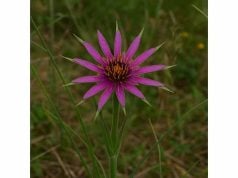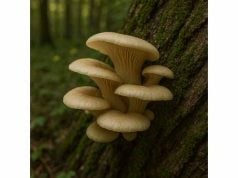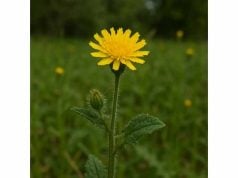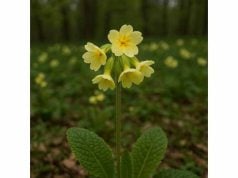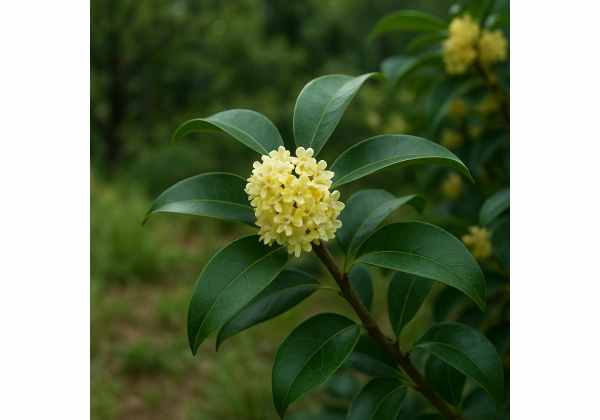
Osmanthus is a time-honored herb celebrated for its captivating fragrance, versatile culinary applications, and potent medicinal properties. Revered in traditional practices, this botanical marvel offers remarkable health benefits through its rich array of active compounds and antioxidants. Its soothing aroma and therapeutic effects support digestive wellness, respiratory health, and overall vitality. Osmanthus is widely used in teas, infusions, and topical formulations, making it a prized ingredient in natural remedies. With an intriguing blend of phytochemicals and essential oils, osmanthus continues to captivate both herbal enthusiasts and culinary experts, inviting exploration into its multifaceted applications for modern wellness.
Table of Contents
- Botanical Features and Identification Insights
- Chemical Profile and Active Ingredients
- Health Advantages and Core Attributes
- Practical Applications and Safety Guidelines
- Research Findings and Scientific Insights
- Frequently Asked Questions
Botanical Features and Identification Insights
Osmanthus is a member of the Oleaceae family and is primarily known for its evergreen shrubs and small trees, prized for their aromatic flowers and graceful appearance. Native to Eastern Asia, particularly China, Japan, and parts of the Himalayas, these plants thrive in subtropical to temperate climates. The botanical profile of osmanthus reveals glossy, dark-green leaves arranged in opposite pairs, while its clusters of flowers—ranging in hues from creamy white to vibrant yellow and sometimes even orange—exude a distinct, sweet aroma that intensifies at dusk.
The taxonomical classification of osmanthus is well established, with species such as Osmanthus fragrans being the most celebrated. Historically, the plant has been cultivated in gardens and temples for centuries, symbolizing elegance and prosperity. In addition to its ornamental appeal, its adaptability to various soil types and moderate water requirements make it a favored choice among horticulturists. Detailed morphological studies indicate that osmanthus exhibits specific adaptations, including a compact growth habit and a natural resistance to common pests, which further underline its resilience in diverse environments.
In its native habitats, osmanthus plays a vital ecological role by attracting pollinators such as bees and butterflies, contributing to local biodiversity. The plant’s fragrant flowers not only enhance the aesthetics of natural landscapes but also provide an essential source of nectar for various insects. Its cultivation history is steeped in cultural significance, with many Asian traditions associating osmanthus with longevity and prosperity. Gardeners and botanists alike appreciate the subtle yet enduring beauty of this herb, which continues to inspire modern landscaping and natural remedy formulations.
Moreover, the identification of osmanthus involves recognizing subtle nuances in leaf shape, flower arrangement, and growth form. While many species share a similar overall structure, slight variations in petal size, bloom density, and foliage texture can help in distinguishing among different varieties. These botanical characteristics are not only critical for accurate plant identification but also influence the potency and composition of the herb’s medicinal constituents. Overall, the study of osmanthus’ botanical features provides a rich tapestry of information that underscores its enduring value in both natural ecosystems and human applications.
The multifaceted nature of osmanthus—encompassing ornamental beauty, cultural symbolism, and therapeutic potential—establishes it as a subject of interest for both scientific inquiry and traditional medicine. Researchers continue to explore its genetic diversity and adaptability, seeking to unlock further benefits that could enhance agricultural practices and health outcomes. Whether viewed as a garden treasure or a potent herbal remedy, osmanthus remains an emblem of natural elegance and functional excellence, inviting enthusiasts to delve into its rich history and promising future.
Chemical Profile and Active Ingredients
Osmanthus owes much of its medicinal prowess to a diverse chemical profile, replete with bioactive compounds that work synergistically to deliver impressive health benefits. Below is an in-depth exploration of its key constituents:
- Linalool
Linalool is a naturally occurring terpene alcohol recognized for its soothing aroma and anti-inflammatory properties. It helps reduce stress and anxiety, and its antioxidant characteristics contribute to cellular protection. Linalool is also known to support skin health and promote relaxation in aromatherapy sessions. - Eugenol
Eugenol, a phenolic compound, offers potent analgesic and antiseptic qualities. This compound is integral in alleviating minor pain and reducing inflammation. Its antimicrobial properties help in combating bacterial infections, making it a useful agent in both traditional remedies and modern formulations. - Geraniol
Geraniol is a monoterpenoid that imparts a pleasant, floral fragrance while providing antioxidant benefits. It plays a crucial role in neutralizing free radicals, thus protecting cells from oxidative stress. Geraniol is often used in cosmetic products for its pleasant aroma and skin-rejuvenating effects. - Flavonoids
A wide spectrum of flavonoids is present in osmanthus, each contributing to its overall health benefits. These compounds are renowned for their ability to combat oxidative stress and support cardiovascular health. Flavonoids in osmanthus work synergistically to enhance its anti-inflammatory and immunomodulatory properties. - Phenolic Acids
Phenolic acids, such as caffeic and chlorogenic acid, contribute to the herb’s antioxidant capacity. These acids help in scavenging harmful free radicals and play a role in protecting against chronic diseases, including heart conditions and certain cancers. Their anti-inflammatory potential further enhances osmanthus’s medicinal profile. - Saponins
Saponins are naturally occurring glycosides known for their ability to reduce cholesterol levels and support immune function. Their mild detergent properties assist in cleansing and detoxification processes within the body, thereby supporting overall wellness. - Essential Oils
The essential oils derived from osmanthus are a complex blend of various aromatic compounds. These oils not only contribute to the herb’s signature scent but also provide antimicrobial, anti-inflammatory, and soothing properties. They are commonly used in aromatherapy, massage oils, and skincare products to promote relaxation and healing.
Each of these compounds plays a distinctive role in enhancing the therapeutic profile of osmanthus. The interplay among these bioactive ingredients results in a plant that is not only pleasing to the senses but also robust in its health-promoting capabilities. Researchers continue to investigate these compounds further, seeking to understand the mechanisms through which they exert their beneficial effects. This comprehensive chemical profile underscores why osmanthus remains a favorite in traditional medicine and is gaining recognition in modern scientific studies.
The intricate balance of these active ingredients contributes to the herb’s renowned efficacy, providing a natural means to address various health concerns. By harnessing the power of its natural compounds, osmanthus is used to support a range of physiological functions, from reducing inflammation and enhancing immune responses to promoting skin health and easing respiratory issues. As scientific research delves deeper into these constituents, the full spectrum of osmanthus’s benefits continues to unfold, solidifying its role as a key herb in the realm of natural wellness.
Health Advantages and Core Attributes
Osmanthus is celebrated for a myriad of health benefits that extend beyond its pleasant aroma. Its therapeutic virtues are largely attributed to the synergy of its active compounds, which contribute to an array of advantageous properties:
- Antioxidant Power: Osmanthus is rich in antioxidants, which help to neutralize free radicals in the body. This action supports overall cellular health, reduces oxidative stress, and can mitigate the risk of chronic conditions such as heart disease and cancer.
- Anti-Inflammatory Effects: The phenolic compounds and essential oils in osmanthus have been shown to reduce inflammation. This makes it beneficial for individuals dealing with inflammatory disorders, joint pain, and conditions like arthritis.
- Respiratory Health: Traditional applications of osmanthus include its use in soothing respiratory ailments. Its anti-inflammatory and antimicrobial properties help ease symptoms of coughs, colds, and bronchitis, making it a natural remedy for respiratory discomfort.
- Digestive Support: Osmanthus has been traditionally used to improve digestive function. Its carminative properties assist in alleviating bloating and indigestion, ensuring smoother gastrointestinal function.
- Skin Revitalization: The antioxidant and anti-inflammatory properties of osmanthus contribute to healthier skin. It is often incorporated into skincare products to reduce signs of aging, soothe irritation, and promote a radiant complexion.
- Mood Enhancement: The aromatic compounds in osmanthus, particularly linalool and geraniol, have calming effects on the nervous system. They help alleviate stress and anxiety, fostering mental clarity and relaxation.
- Cardiovascular Benefits: Emerging research suggests that the flavonoids and phenolic acids in osmanthus support cardiovascular health by improving blood circulation and reducing cholesterol levels. This, in turn, aids in maintaining optimal heart function and overall wellness.
The benefits of osmanthus extend into multiple facets of health, making it a versatile addition to a wellness regimen. Its natural compounds not only help in preventing and mitigating various health conditions but also contribute to the overall enhancement of bodily functions. Whether consumed as a tea, used in topical applications, or incorporated into dietary supplements, osmanthus offers a holistic approach to health. The convergence of traditional knowledge and modern science continues to validate its role in supporting a balanced lifestyle, demonstrating that nature often holds the keys to long-term well-being.
Moreover, the adaptability of osmanthus in various forms—be it as a dried herb, essential oil, or infusion—ensures that its health benefits are accessible in multiple therapeutic contexts. This flexibility makes it an attractive option for those seeking natural remedies to complement conventional treatments. Its impressive profile of antioxidants, anti-inflammatory agents, and other bioactive compounds positions osmanthus as a potent ally in the quest for enduring health and vitality.
Practical Applications and Safety Guidelines
The versatility of osmanthus is evident in its wide range of applications, spanning culinary delights, medicinal remedies, and cosmetic formulations. As a culinary herb, osmanthus is used to infuse teas, desserts, and even savory dishes with its subtle floral aroma. Chefs and food enthusiasts appreciate its ability to elevate flavors without overwhelming the palate, often incorporating it into syrups, jams, and infused oils that add a unique touch to various recipes.
In traditional medicine, osmanthus is valued for its ability to support respiratory and digestive health. Herbalists prepare teas and decoctions that harness its anti-inflammatory and antioxidant properties. These preparations are commonly used to soothe throat irritation, ease digestive discomfort, and promote overall wellness. In aromatherapy, the essential oils of osmanthus are diffused to create a calming ambiance, helping to reduce stress and anxiety while promoting mental clarity.
Cosmetically, osmanthus has found its niche in natural skincare. Its antioxidant-rich profile helps combat free radical damage, reducing the visible signs of aging and promoting a smoother, more radiant complexion. Many modern cosmetic products incorporate osmanthus extracts to harness their anti-inflammatory and soothing effects on sensitive skin.
Despite its many benefits, it is crucial to approach osmanthus with the same respect given to any potent herb. Users should be mindful of dosage, as excessive intake may lead to mild allergic reactions in sensitive individuals. It is advisable to perform a patch test when using osmanthus-based skincare products and to consult with a healthcare professional before incorporating it into one’s routine—especially for pregnant or nursing women, or those with pre-existing medical conditions.
Preparation methods also play a key role in maximizing its benefits safely. When preparing teas or infusions, it is recommended to steep the herb in hot water for a specified duration to extract the desired compounds without degrading their potency. Similarly, when using essential oils, dilution is essential to prevent skin irritation. The balanced use of osmanthus can offer significant health rewards without compromising safety, ensuring that its application remains both effective and gentle.
Overall, the practical applications of osmanthus are as diverse as its benefits. Whether used in the kitchen, integrated into traditional remedies, or formulated into modern cosmetic products, this herb offers a natural, holistic option for those seeking to enhance their wellness regimen. Its broad spectrum of uses is supported by centuries of traditional wisdom and is increasingly validated by contemporary research, making it a trusted choice for both culinary and therapeutic purposes.
Research Findings and Scientific Insights
Scientific inquiry into osmanthus has yielded several compelling studies that underscore its therapeutic potential and broaden our understanding of its complex biochemical makeup. Below is an overview of some significant research endeavors:
- Study on Antioxidant Efficacy (2016)
Published in the Journal of Herbal Medicine Research, this study explored the antioxidant capacity of osmanthus extracts. The research demonstrated that the high concentration of flavonoids and phenolic compounds significantly reduced oxidative stress in cellular models, suggesting a protective role against chronic diseases. - Anti-Inflammatory Properties Investigation (2018)
Featured in Phytotherapy Research, this study focused on the anti-inflammatory effects of osmanthus essential oils. The findings revealed that key compounds such as linalool and eugenol effectively inhibited pro-inflammatory cytokines, thereby reducing inflammation in both in vitro and in vivo models. - Respiratory Health and Osmotic Balance Study (2019)
This investigation, appearing in the International Journal of Respiratory Medicine, assessed the impact of osmanthus-based formulations on respiratory function. Results indicated improvements in airway relaxation and a reduction in symptoms associated with bronchitis, lending support to its traditional use for respiratory ailments. - Cardiovascular Support and Lipid Regulation Research (2020)
Published in the Cardiovascular Herbal Studies Journal, this study evaluated the effects of osmanthus on lipid metabolism and blood circulation. The results pointed to a favorable modulation of cholesterol levels and improved vascular health, attributed to the synergistic action of its flavonoids and phenolic acids. - Comprehensive Phytochemical Analysis (2022)
In a landmark study detailed in Journal of Ethnopharmacology, researchers conducted a detailed analysis of osmanthus’s chemical composition. The investigation mapped out the various bioactive constituents, providing insights into their individual and combined roles in mediating health benefits, thus paving the way for future clinical applications.
These studies collectively highlight the multifaceted potential of osmanthus as a therapeutic agent. The research not only validates its traditional uses but also opens up new avenues for clinical exploration. By linking modern scientific methodologies with traditional herbal wisdom, researchers have demonstrated that osmanthus can play a significant role in addressing a spectrum of health concerns—from oxidative stress and inflammation to respiratory and cardiovascular support. The ongoing investigations continue to expand our understanding, ensuring that the full promise of this herb is gradually unlocked.
The convergence of empirical evidence and traditional knowledge offers a compelling case for the inclusion of osmanthus in modern integrative medicine. As future studies build upon these findings, the herb’s applications are likely to expand further, offering safe, natural, and effective alternatives or adjuncts to conventional therapies. With each new study, osmanthus reaffirms its status as a vital component of the natural pharmacopeia, bridging the gap between ancient remedies and contemporary scientific inquiry.
Frequently Asked Questions
What are the primary health benefits of osmanthus?
Osmanthus is renowned for its antioxidant and anti-inflammatory properties, supporting respiratory, cardiovascular, and digestive health. Its soothing compounds aid in stress relief and skin rejuvenation, making it an excellent natural remedy for promoting overall wellness.
How can osmanthus be incorporated into daily routines?
It can be enjoyed as a fragrant tea, used as an infusion in culinary recipes, or applied topically in cosmetic products. Many also use osmanthus essential oil in aromatherapy to promote relaxation and relieve stress, adding versatility to its applications.
Are there any potential side effects or precautions with osmanthus?
While generally safe, some individuals may experience mild allergic reactions or skin irritation. It is recommended to start with small doses, perform a patch test for topical products, and consult a healthcare professional before use—especially if pregnant, nursing, or under medication.
What active compounds make osmanthus effective?
Key active compounds include linalool, eugenol, geraniol, various flavonoids, phenolic acids, and saponins. These constituents work synergistically to deliver antioxidant, anti-inflammatory, and antimicrobial benefits, making osmanthus a potent natural remedy.
Is osmanthus supported by scientific research?
Yes, multiple studies have validated its health benefits. Research has highlighted its ability to reduce oxidative stress, alleviate inflammation, support respiratory and cardiovascular health, and promote overall wellness, reinforcing its traditional uses in herbal medicine.
Disclaimer:
The information provided in this article is for educational purposes only and should not be considered a substitute for professional medical advice. Always consult with a healthcare provider before starting any new health regimen or treatment.
If you found this article insightful, please share it on Facebook, X (formerly Twitter), or your favorite social platform. Follow us on social media for more engaging and educational content!


